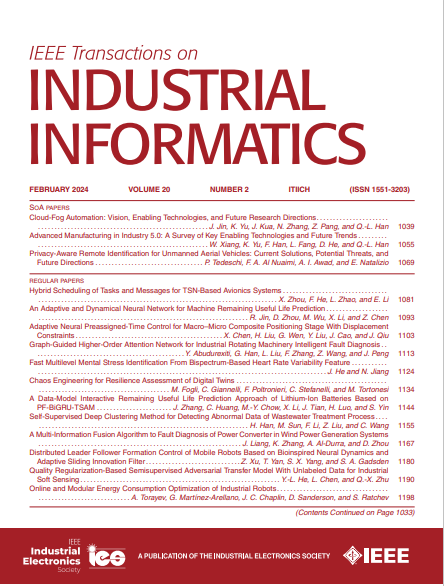柯尔莫哥洛夫卷积网络:船岸起重机台车机构故障诊断的知识表示与推理
IF 9.9
1区 计算机科学
Q1 AUTOMATION & CONTROL SYSTEMS
引用次数: 0
摘要
船岸起重机小车机构的准确故障诊断对保证港口货物运输至关重要。虽然深度神经网络(DNN)在故障识别方面取得了一些成就,但DNN固有的不透明性往往限制了提供可靠解释和与领域专家互动的能力。在神经符号集成领域,研究人员越来越关注从深度神经网络中提取关系知识的方法,以提供对深度神经网络特征学习和推理过程的语义理解,使其内部决策机制更加透明和可信。本文介绍了一种Kolmogorov卷积网络(KCN),它提取关系知识,使卷积操作可视化,同时支持类似于IF-THEN形式的语义推理。在卷积可视化方面,基于Kolmogorov表示定理,引入了具有可训练激活函数的Kolmogorov卷积(KC),该卷积可以表示基于多个单变量函数的输入和特征映射之间的非线性关系。为了实现全连通层的可视化,设计了一种新的规则格式——分类规则,为故障诊断提供了一种语义表示。最后,在1:4 STSC测试平台上进行的实验表明,KCN的诊断准确率达到了98.3%,优于传统模型,并展示了优化先验知识使用的潜力。使用Levenberg-Marquardt优化,KC的计算效率提高了37%。KCN的关系知识与领域知识的相似性表明,KCN在先验诊断规则优化等领域具有实用价值。这些发现表明,在工业场景中,KCN是一种很有前途的准确和可解释的故障诊断方法。本文章由计算机程序翻译,如有差异,请以英文原文为准。
Kolmogorov Convolution Network: Knowledge Representation and Reasoning for Fault Diagnosis of Trolley Mechanism on Ship-to-Shore Cranes
Accurate fault diagnosis of trolley mechanisms in ship-to-shore cranes is essential for ensuring cargo transportation at ports. While deep neural networks (DNNs) have made some achievements in fault recognition, DNN’s inherent opacity often limits the ability to provide reliable explanations and interact with domain experts. In the field of neural-symbolic integration, researchers are increasingly focusing on methods to extract relational knowledge from DNNs to offer a semantic understanding of the DNN’s feature learning and reasoning processes, making their internal decision-making mechanisms more transparent and trustworthy for operators. This article introduces a Kolmogorov convolution network (KCN), which extracts relational knowledge that visualizes convolutional operations and simultaneously supports semantic reasoning similar to the IF-THEN form. For convolution visualization, based on the Kolmogorov representation theorem, we introduce a Kolmogorov convolution (KC) with trainable activation functions, which can represent the nonlinear relationships between input and feature maps based on several univariate functions. For the visualization of fully connected layers, a new rule format, classification rules, is designed to provide a semantic representation for fault diagnosis. Finally, experiments, conducted on a 1:4 STSC testbed, demonstrate that KCN achieves its outstanding diagnostic accuracy of 98.3% which outperforms conventional models, and demonstrates potential for optimizing prior knowledge use. The computational efficiency of KC increases by 37% using Levenberg–Marquardt optimization. The resemblance between relational knowledge from KCN and domain knowledge indicates that KCNs possess practical value in areas such as the optimization of prior diagnostic rules. These findings indicate that KCN is a promising approach for accurate and interpretable fault diagnosis in industrial scenarios.
求助全文
通过发布文献求助,成功后即可免费获取论文全文。
去求助
来源期刊

IEEE Transactions on Industrial Informatics
工程技术-工程:工业
CiteScore
24.10
自引率
8.90%
发文量
1202
审稿时长
5.1 months
期刊介绍:
The IEEE Transactions on Industrial Informatics is a multidisciplinary journal dedicated to publishing technical papers that connect theory with practical applications of informatics in industrial settings. It focuses on the utilization of information in intelligent, distributed, and agile industrial automation and control systems. The scope includes topics such as knowledge-based and AI-enhanced automation, intelligent computer control systems, flexible and collaborative manufacturing, industrial informatics in software-defined vehicles and robotics, computer vision, industrial cyber-physical and industrial IoT systems, real-time and networked embedded systems, security in industrial processes, industrial communications, systems interoperability, and human-machine interaction.
 求助内容:
求助内容: 应助结果提醒方式:
应助结果提醒方式:


